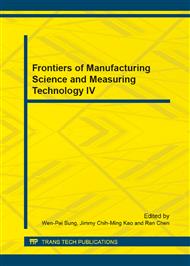p.814
p.819
p.823
p.827
p.831
p.835
p.841
p.847
p.851
Application of Parameter-Adaptative Fuzzy PID Control in the Temperature Control System for Liquor Filling and Sealing Machine
Abstract:
In order to improve pass-rate of liquor filling products; avoid poor quality as a result of liquor leakage and volatility, the sealing device for liquor filling and sealing machine has been improved, a parameter-adaptative fuzzy PID controller and a temperature control device based on a single chip microprocessor have been designed. Practical applications have shown that the parameter-adaptive fuzzy PID control system has high control precision and good tracking performance, small overshoot, strong anti-voltage disturbance, stable and reliable heat seal connection quality, and can meet the requirement of production process. Key words:liquor filling and sealing machine,parameter-adaptative fuzzy PID control,single chip microcomputer,temperature control ,sealing device
Info:
Periodical:
Pages:
831-834
Citation:
Online since:
August 2014
Authors:
Price:
Сopyright:
© 2014 Trans Tech Publications Ltd. All Rights Reserved
Share:
Citation:


